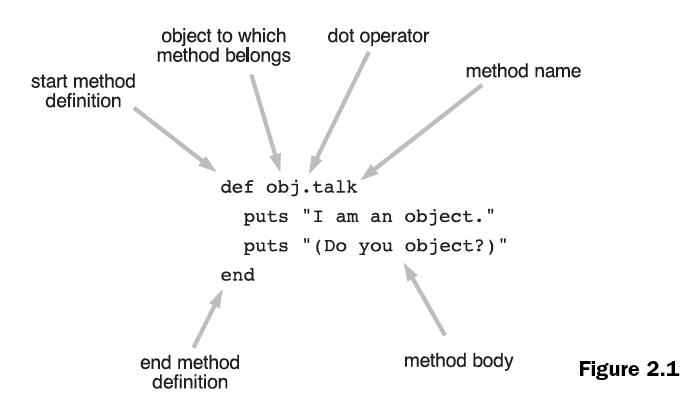Slides
Ruby Objects
This section introduces Ruby's object-oriented programming model, including instances, methods, parameters, and memory management (instances and references). Later sections cover classes and modules and further topics.
Ref: WGR Chapter 2. Objects, methods, and local variables
Note: Following WGR's lead, in this section we define methods on instances (not on classes), to keep the lessons simple.
What is an object?
What is an object?
-
An object encapsulates state and behavior.
- encapsulate - put like things together; keep unlike things apart
- state - data, variables, properties, attributes, constants
- behavior - methods
The Linguistic Metaphor for Objects
One way to think about objects:
Objects are things that can be described and can do things, or...
- Objects are nouns
- Methods are verbs
- Attributes are adjectives
- Classes are categories
Objects vs. Classes
- objects are more fundamental than classes
- in Ruby, you can add behavior to an object directly
- class inheritance is complicated
- we'll cover it later
Creating an object
cookie = Object.new
- now
cookierefers to an object instance- unique storage location in memory
- instance data stored in that location
Creating an object literally
fruit = "apple"
-
"apple"is a string literal -
fruitnow refers to a new object instance
References and Instances
- Imagine computer memory with two compartments: references and instances
- also known as "the stack" (or "the scope") and "the heap"
- References include parameters and local variables
- Instances contain the "real" data
- Each reference points at the location of an instance
- every reference is the same size (just 32 bits, or maybe 64 bits)
| Stack | Heap | |
|---|---|---|
| fruit | -> | "apple" |
Literals create instances
fruit = "apple"
dessert = "apple"
-
fruitrefers to a new object instance -
dessertrefers to a different, new object instance
| Stack | Heap | |
|---|---|---|
| fruit | -> | "apple" |
| dessert | -> | "apple" |
References are independent of instances
fruit = "apple"
dessert = fruit
fruit = "banana"
dessert = fruit
What are the values of fruit and dessert after each line?
Object Identity
How can you tell if two references point to the same instance?
fruit = "apple"
dessert = "apple"
>> fruit.object_id
=> 2165091560
>> dessert.object_id
=> 2165084200
Ref. WGR Ch.2, Section 2.3.1
Object Equality
- Many ways to compare objects
-
==params are equal (overridable) -
.eql?params are equal and the same type -
.equal?params are identical (sameobject_id)
-
-
==is usually what you want
Note that .equal? is not guaranteed since bizarrely, some objects override .equal? to do something else. If you really want to know if two variables reference the same instance, compare their object_ids.
Garbage Collection
fruit = "apple"
fruit = "banana"
- Now the instance containing "apple" is unreferenced
- So it can (and eventually will) be garbage collected
Side effects
- a variable is a reference to an instance (persistent location in memory)
- if you have several references to the same instance, odd things can happen
friend = "Alice"
teacher = friend
friend.upcase!
teacher
=> "ALICE"
Behavior
Defining methods
cookie = Object.new
def cookie.bake
puts "the oven is nice and warm"
end
- bake is a method
- aka function, procedure, subroutine
-
def cookie.("def cookie dot") means "define a method on cookie"
Invoking methods
Behavior comes from messages and methods.
cookie.bake
prints I'm a cookie to the console
- the object
cookiereceives the messagebakeand executes the methodbake - dot (
.) is the message operator
Method Definition Schematic

Ref. The Well-Grounded Rubyist PDF, Fig. 2.1
The methods method
>> cookie.methods
=> [:nil?, :===, :=~, :!~, :eql?, ...]
>> cookie.methods(false)
=> [:bake]
also useful: cookie.methods.sort, cookie.methods.grep(/age/)
>> cookie = Object.new
=> #<Object:0x007f86e485c3a8>
>> cookie.methods(false)
=> []
>> def cookie.bake; puts "hi"; end
=> nil
>> cookie.methods(false)
=> [:bake]
>> "goo".methods.grep(/sub/)
=> [:sub, :gsub, :sub!, :gsub!]
The respond_to? method
if cookie.respond_to? :bake
cookie.bake
else
puts "cookie is unbakable"
end
Note: Usually you don't use respond_to because of duck typing.
State
Instance variables are stored in the object
def cookie.add_chips(num_chips)
@chips = num_chips
end
def cookie.yummy?
@chips > 100
end
cookie.add_chips(500)
cookie.yummy? #=> true
Self
- All OO programs suffer from multiple personality disorder
-
selfis the default message receiver -
selfis set invisibly to always point to the current object
Self Example
def cookie.yummy?
@chips > 100
end
def cookie.add_chips(num_chips = 10)
@chips
@chips += num_chips
end
def cookie.yummify
add_chips until yummy?
end
- inside
yummifythe call toyummy?goes toself
Labs
Outline
- Ruby Objects
- What is an object?
- What is an object?
- The Linguistic Metaphor for Objects
- Objects vs. Classes
- Creating an object
- Creating an object *literally*
- References and Instances
- Literals create instances
- References are independent of instances
- Object Identity
- Object Equality
- Garbage Collection
- Side effects
- Behavior
- Defining methods
- Invoking methods
- Method Definition Schematic
- The `methods` method
- The `respond_to?` method
- State
- Instance variables are stored in the object
- Self
- Self Example
- Labs